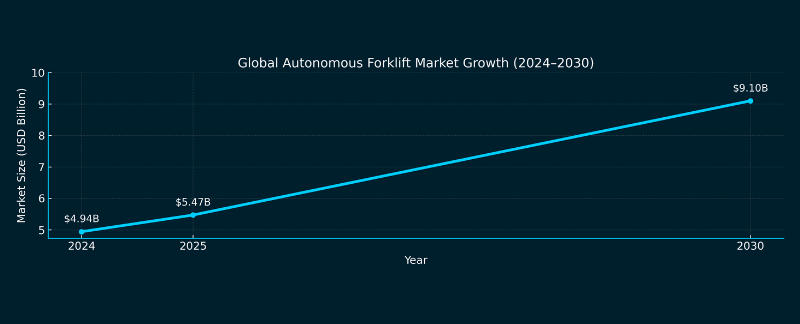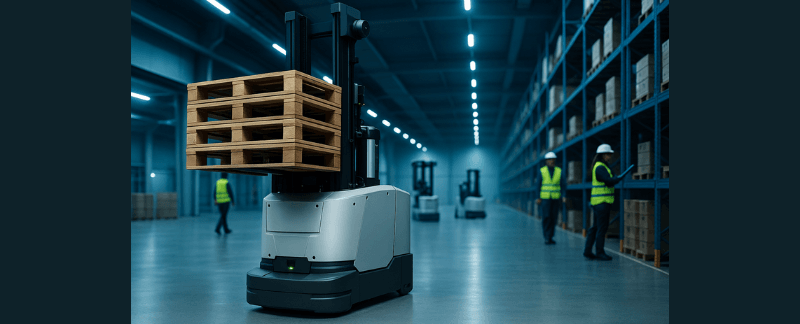Autonomous Forklift & AI Vision: Smarter Warehouse Safety
Autonomous forklifts are transforming modern warehouses, offering unmatched efficiency, precision and scalability. But when these driverless machines operate in dynamic environments shared with human workers, safety becomes a critical concern.
That’s where AI-powered vision systems like Blaxtair come in, providing real-time pedestrian detection, obstacle awareness, and smart alerts to prevent collisions.
Rise of Autonomous Forklifts in Logistics
Autonomous material handling vehicles are no longer a futuristic concept, but a fast-growing reality. According to a 2024 report by Next Move Strategy Consulting (Next MSC), the global autonomous forklift market is expected to reach USD 5.47 billion by 2025, up from USD 4.94 billion in 2024. The industry is predicted to grow further to USD 9.10 billion by 2030, with a compound annual growth rate (CAGR) of 10.7% from 2025 to 2030.
This rapid expansion is driven by labor shortages, rising e-commerce demands, and the push for 24/7 warehouse automation.
But while autonomous forklifts offer productivity gains through continuous operation, reduced human error, and optimized workflows, their integration into shared human-machine environments poses new safety challenges. These machines must handle unpredictable scenarios – sudden pedestrian movements, falling pallets, or sharp turns in aisles – all without a human operator.
That’s why vision still matters, even without a driver. Autonomy manages movement, but safety requires perception, especially when humans are involved. AI-powered vision systems act as the forklift’s eyes, enabling it to perceive and understand its environment with the nuances and context needed to prevent accidents.

AI Camera Systems: A Critical Safety Layer
Detecting Pedestrians in Shared Spaces
Autonomous forklifts often operate in spaces where human workers are walking, crossing aisles, or picking from inventory. AI camera systems, such as Blaxtair, are trained to recognize pedestrians with high accuracy, even in cluttered, low-visibility environments.
Unlike traditional proximity sensors, which simply detect an object, AI cameras identify whether that object is a person or not. This distinction is essential when navigating complex, real-world warehouse configurations.
Minimizing False Alarms vs. Necessary Alerts
An excessive number of false alarms from traditional sensors, such as basic ultrasonic or radar systems, can disrupt autonomous operations. When these sensors are unable to distinguish between a human and a harmless object, they may trigger unnecessary slowdowns or emergency stops, causing delays and reducing operational efficiency.
AI vision systems like Blaxtair use deep learning to interpret complex environments and accurately detect pedestrians. By minimizing false positives, the smooth operation of autonomous forklifts, which only stop or adjust their speed when a real risk is identified.
Integration with AGV (Automated Guided Vehicles) & AMR (Autonomous Mobile Robots) platforms
Many warehouses today use a mix of automated guided vehicles (AGVs), autonomous mobile robots (AMRs), and traditional forklifts. AI camera systems can be integrated into these platforms to offer consistent safety protocols across the entire fleet.
Whether mounted on AGVs or collaborative robots, AI vision solutions enable all machines to operate with a shared understanding of pedestrian risk, improving coordination and minimizing safety blind spots across the facility.
How Blaxtair Enhances Autonomous Forklifts
Blaxtair’s advanced AI vision solution brings several key improvements to autonomous forklift operations:
- Real-time human vs. object recognition
Blaxtair’s embedded vision system instantly distinguishes pedestrians from other obstacles, allowing the forklift to react appropriately, whether slowing down, stopping or changing routes. - Sensor fusion with Lidar and internal navigation
Blaxtair can be used alongside existing navigation systems such as Lidar, GPS, or SLAM to provide an additional layer of perception. This redundancy enhances safety and allows the vehicle to react to human presence beyond its planned route. - Proactive risk zone monitoring.
The system continuously monitors predefined high-risk zones, such as intersections, crosswalks, or blind spots. When a pedestrian enters these areas, the system immediately flags the risk and triggers a response.
Use Cases in Warehouses and Manufacturing
Multi-vehicle environments (AGV + manual forklifts)
In mixed-traffic environments, where autonomous forklifts share space with manual vehicles, accidents are more likely to occur due to inconsistent behavior between machine types. AI-based vision systems provide an extra layer of situational awareness, helping autonomous vehicles adapt to unpredictable human behavior.
Blaxtair enables smooth collaboration between AGVs and manual forklifts by prioritizing pedestrian detection and stopping protocols regardless of who’s driving (or not driving) the machine.
Crosswalks, aisles, and loading zones
High-traffic areas such as pedestrian crossings, narrow aisles, and loading docks are frequent sites of near-misses and collisions. AI-powered systems like Blaxtair can be programmed to recognize these zones and apply stricter detection parameters, ensuring maximum vigilance.
For example, when a worker crosses in front of an autonomous forklift carrying pallets, Blaxtair immediately triggers a warning, prompting the machine to stop or slow down, even if the pedestrian is partially obscured by shelves or boxes.

Regulations & Futureproofing Your Safety Strategy
In the United States, autonomous forklifts must comply with rigorous safety standards, including ANSI/ITSDF B56.5, which governs driverless industrial trucks. These regulations emphasize not only the mechanical integrity of the vehicle but also its ability to detect and avoid people.
AI systems like Blaxtair help warehouses remain compliant by meeting and exceeding these standards. The technology also supports documentation and data logging for certification processes and internal audits, essential to future-proofing your warehouse safety strategy.
Investing in AI vision isn’t just about current compliance: it’s about preparing for future regulations that will likely demand higher levels of automation accountability.
Potential Application: AI Vision in Hybrid Autonomous Fleets
While many autonomous forklift deployments are still in early stages, the integration of AI-powered vision systems like Blaxtair paves the way for safer mixed environments, where manual, semi-autonomous, and autonomous vehicles operate side by side.
Industrial sites exploring automation have reported strong interest in AI perception layers to proactively protect pedestrians and support safety audits. Although large-scale hybrid fleet deployments remain rare, early pilots show promising potential for:
- Improving pedestrian visibility in high-traffic areas
- Preventing emergency stops caused by false alarms
- Building operator and warehouse staff confidence
- Supporting OSHA compliance through video recording of safety events
With the growing adoption of autonomous forklifts, forward-thinking facilities are already evaluating how AI vision can future-proof their safety strategies.
Conclusions
Autonomous forklifts are revolutionizing logistics and manufacturing, but to fully realize their potential, they must be equipped with AI vision systems that ensure operator safety. The synergy between automation and AI safety platforms like Blaxtair creates smarter, more reliable, and regulatory-compliant warehouse environments.
FAQs
Are AI camera systems really necessary for autonomous forklifts in U.S. warehouses?
Yes, AI vision systems like Blaxtair are essential for safety in U.S. warehouses where autonomous forklifts operate near workers. They detect pedestrians in real time and reduce collision risks, especially in shared spaces like crosswalks and loading areas.
How do autonomous forklifts with AI vision improve safety in mixed environments with manual equipment?
In U.S. warehouses using both AGVs and manual forklifts, AI-powered systems help autonomous vehicles distinguish between humans and objects, minimizing accidents and ensuring safe operation in dynamic, mixed-traffic areas.
What U.S. safety standards apply to autonomous forklifts with AI systems?
In the U.S., autonomous forklifts must comply with ANSI/ITSDF safety standards. AI systems like Blaxtair help meet these requirements by proactively monitoring risk areas and supporting warehouse certification and audit readiness.
Want to protect your team and maximize the return on investment from your autonomous fleet? Request a free consultation with our experts today.


